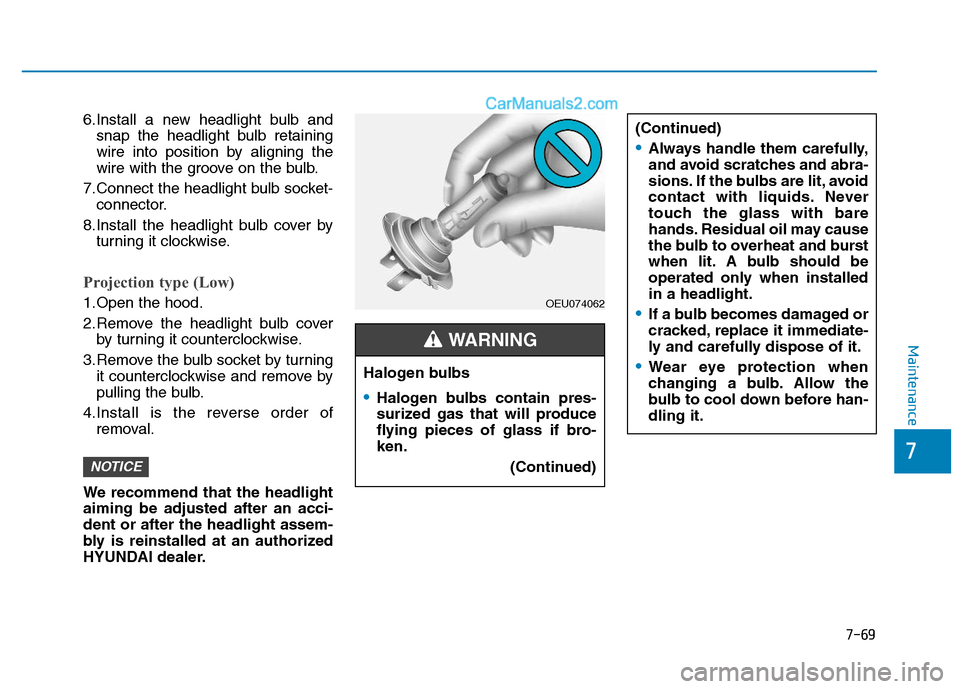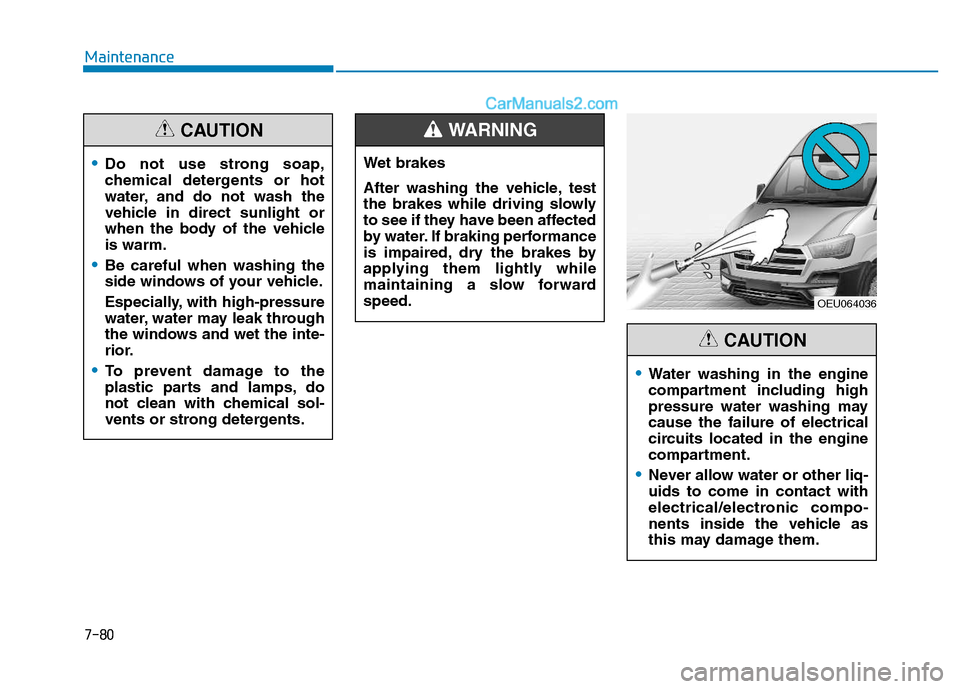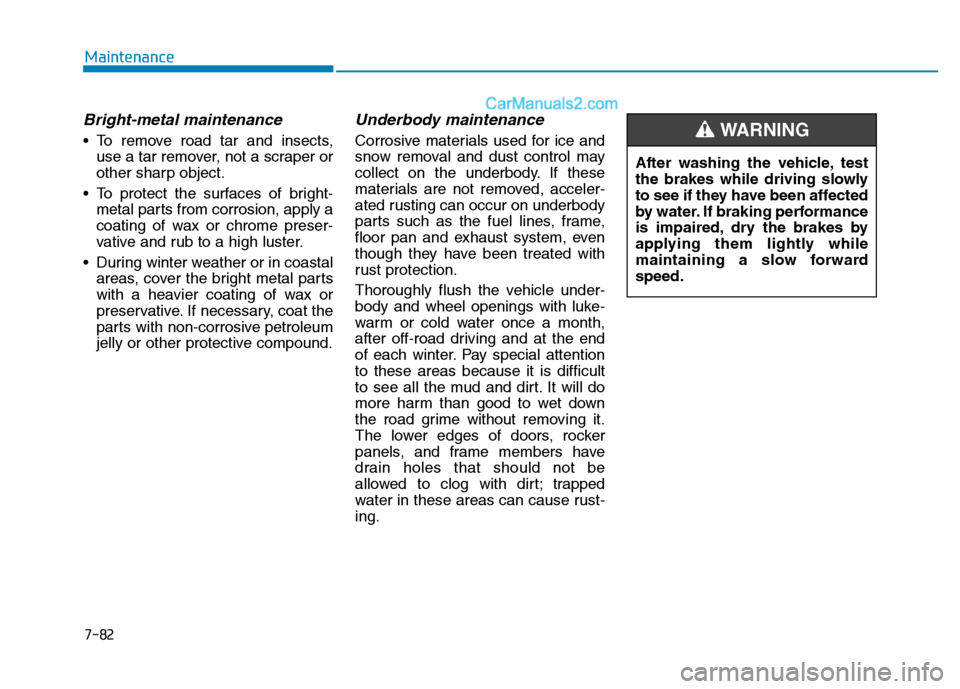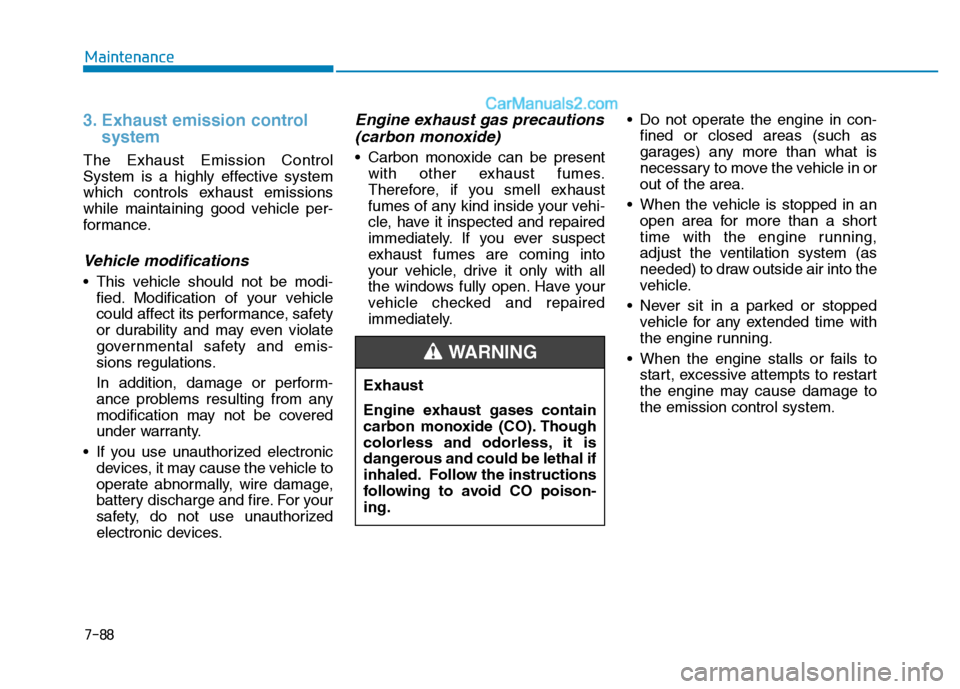2016 Hyundai H350 warning
[x] Cancel search: warningPage 432 of 473

7-69
7
Maintenance
6.Install a new headlight bulb andsnap the headlight bulb retaining
wire into position by aligning the
wire with the groove on the bulb.
7.Connect the headlight bulb socket- connector.
8.Install the headlight bulb cover by turning it clockwise.
Projection type (Low)
1.Open the hood.
2.Remove the headlight bulb coverby turning it counterclockwise.
3.Remove the bulb socket by turning it counterclockwise and remove by
pulling the bulb.
4.Install is the reverse order of removal.
We recommend that the headlightaiming be adjusted after an acci-dent or after the headlight assem-
bly is reinstalled at an authorized
HYUNDAI dealer.
NOTICE
Halogen bulbs
Halogen bulbs contain pres-
surized gas that will produce
flying pieces of glass if bro-ken. (Continued)
(Continued)
Always handle them carefully,
and avoid scratches and abra-
sions. If the bulbs are lit, avoid
contact with liquids. Never
touch the glass with bare
hands. Residual oil may cause
the bulb to overheat and burst
when lit. A bulb should be
operated only when installedin a headlight.
If a bulb becomes damaged or
cracked, replace it immediate-
ly and carefully dispose of it.
Wear eye protection when
changing a bulb. Allow the
bulb to cool down before han-dling it.
WARNING
OEU074062
Page 442 of 473

7-79
7
Maintenance
3.Install a new bulb in the socket.
4.Align the lens tabs with the interiorlight housing notches and snap the
lens into place.
Exterior care
Exterior general caution
It is very important to follow the label
directions when using any chemical
cleaner or polish. Read all warningand caution statements that appearon the label.
Finish maintenance
Washing
To help protect your vehicle’s finish
from rust and deterioration, wash itthoroughly and frequently at least
once a month with lukewarm or cold
water.
If you use your vehicle for off-road
driving, you should wash it after each
off-road trip. Pay special attention to
the removal of any accumulation of
salt, dirt, mud, and other foreign
materials. Make sure the drain holes
in the lower edges of the doors and
rocker panels are kept clear andclean.
Insects, tar, tree sap, bird droppings,
industrial pollution and similar
deposits can damage your vehicle’s
finish if not removed immediately.
Even prompt washing with plain
water may not completely remove all
these deposits.
A mild soap, safe for use on painted
surfaces, may be used.
After washing, rinse the vehicle thor-
oughly with lukewarm or cold water.
Do not allow soap to dry on the fin-ish.
Prior to working on the Interior
Lights, ensure that the “OFF”
button is depressed to avoid
burning your fingers or receiv-
ing an electric shock.
WARNING
Use care not to dirty or damage
lens, lens tab, and plastic hous-ings.
CAUTION
AA
PPPPEEAA RRAA NN CCEE CC AA RREE
Page 443 of 473

7-80
Maintenance
Do not use strong soap,
chemical detergents or hot
water, and do not wash the
vehicle in direct sunlight or
when the body of the vehicleis warm.
Be careful when washing the
side windows of your vehicle.
Especially, with high-pressure
water, water may leak through
the windows and wet the inte-
rior.
To prevent damage to the
plastic parts and lamps, do
not clean with chemical sol-
vents or strong detergents.
CAUTION
Wet brakes
After washing the vehicle, test
the brakes while driving slowly
to see if they have been affected
by water. If braking performance
is impaired, dry the brakes by
applying them lightly while
maintaining a slow forwardspeed.
WARNING
OEU064036
Water washing in the engine
compartment including high
pressure water washing maycause the failure of electrical
circuits located in the engine
compartment.
Never allow water or other liq- uids to come in contact with
electrical/electronic compo-
nents inside the vehicle as
this may damage them.
CAUTION
Page 445 of 473

7-82
Maintenance
Bright-metal maintenance
To remove road tar and insects,use a tar remover, not a scraper or
other sharp object.
To protect the surfaces of bright- metal parts from corrosion, apply a
coating of wax or chrome preser-
vative and rub to a high luster.
During winter weather or in coastal areas, cover the bright metal parts
with a heavier coating of wax or
preservative. If necessary, coat the
parts with non-corrosive petroleum
jelly or other protective compound.
Underbody maintenance
Corrosive materials used for ice and
snow removal and dust control may
collect on the underbody. If these
materials are not removed, acceler-
ated rusting can occur on underbody
parts such as the fuel lines, frame,
floor pan and exhaust system, even
though they have been treated with
rust protection.
Thoroughly flush the vehicle under-
body and wheel openings with luke-
warm or cold water once a month,
after off-road driving and at the end
of each winter. Pay special attentionto these areas because it is difficult
to see all the mud and dirt. It will do
more harm than good to wet down
the road grime without removing it.
The lower edges of doors, rocker
panels, and frame members have
drain holes that should not be
allowed to clog with dirt; trapped
water in these areas can cause rust-ing. After washing the vehicle, test
the brakes while driving slowly
to see if they have been affected
by water. If braking performance
is impaired, dry the brakes by
applying them lightly while
maintaining a slow forwardspeed.WARNING
Page 451 of 473

7-88
Maintenance
3. Exhaust emission control system
The Exhaust Emission Control
System is a highly effective system
which controls exhaust emissions
while maintaining good vehicle per-
formance.
Vehicle modifications
This vehicle should not be modi-fied. Modification of your vehicle
could affect its performance, safety
or durability and may even violate
governmental safety and emis-
sions regulations.
In addition, damage or perform-
ance problems resulting from any
modification may not be covered
under warranty.
If you use unauthorized electronic devices, it may cause the vehicle to
operate abnormally, wire damage,
battery discharge and fire. For your
safety, do not use unauthorized
electronic devices.
Engine exhaust gas precautions
(carbon monoxide)
Carbon monoxide can be present with other exhaust fumes.
Therefore, if you smell exhaust
fumes of any kind inside your vehi-
cle, have it inspected and repaired
immediately. If you ever suspect
exhaust fumes are coming into
your vehicle, drive it only with all
the windows fully open. Have your
vehicle checked and repaired
immediately. Do not operate the engine in con-
fined or closed areas (such as
garages) any more than what is
necessary to move the vehicle in orout of the area.
When the vehicle is stopped in an open area for more than a short
time with the engine running,
adjust the ventilation system (as
needed) to draw outside air into the
vehicle.
Never sit in a parked or stopped vehicle for any extended time with
the engine running.
When the engine stalls or fails to start, excessive attempts to restart
the engine may cause damage tothe emission control system.
Exhaust
Engine exhaust gases contain
carbon monoxide (CO). Though
colorless and odorless, it is
dangerous and could be lethal if
inhaled. Follow the instructions
following to avoid CO poison-ing.
WARNING
Page 452 of 473

7-89
7
Maintenance
Operating precautions for cat-alytic converters (if equipped)Your vehicle is equipped with a cat-
alytic converter emission control
device.
Therefore, the following precautions
must be observed:
Do not operate the vehicle when there are signs of engine malfunc-
tion, such as misfire or a noticeable
loss of performance.
Do not misuse or abuse the engine. Examples of misuse arecoasting with the ignition off and
descending steep grades in gear
with the ignition off.
Do not operate the engine at high idle speed for extended periods (5
minutes or more).
Do not modify or tamper with any part of the engine or emission con-
trol system. We recommend that
the system be inspected by an
authorized HYUNDAI dealer.
Avoid driving with a extremely low fuel level. Running out of fuel
cause the engine to misfire, dam-
aging the catalytic converter. Failure to observe these precautionscould result in damage to the catalyt-
ic converter and to your vehicle.
Additionally, such actions could void
your warranties.
Fire
A hot exhaust system can
ignite flammable items under
your vehicle. Do not park,
idle, or drive the vehicle over
or near flammable objects,
such as dry grass, paper,
leaves, etc.
The exhaust system and cat-
alytic system are very hotwhile the engine is running or
immediately after the engine
is turned off. Keep away from
the exhaust system and cat-
alytic, you may get burned.
Also, do not remove the heat
sink around the exhaust sys-
tem, do not seal the bottom of
the vehicle or do not coat the
vehicle for corrosion control.
It may present a fire risk under
certain conditions.
WARNING
Page 453 of 473

7-90
Maintenance
Diesel Particulate Filter (if equipped)
The Diesel Particulate Filter (DPF)
system removes the soot emitted
from the vehicle.
Unlike a disposable air filter, the DPF
system automatically burns (oxi-
dizes) and removes the accumulated
soot according to the driving condi-
tion. In other words, the active burn-
ing by engine control system and
high exhaust gas temperature
caused by normal/high driving condi-
tion burns and removes the accumu-lated soot.
However, if the vehicle continues to
be driven in short distance repeated-
ly or at low speed for a long time, the
accumulated soot may not be auto-
matically removed because of low
exhaust gas temperature. In this par-
ticular case, if the amount of soot is
out of detection limit, the DPF warn-
ing indicator ( ) will illuminate. In order to start the DPF regenera-
tion and to stop the DPF warning
lamp illuminating, drive the vehicle in
a safety driving circumstance with
more than 60km/h (37 mph) vehiclespeed or with more than secondgear engaged and 1500 ~ 2000
engine rpm for a certain time (for
about 25 minutes).
If the DPF warning indicator( )
continues to blink or "check emissionsystem" message comes on in the
cluster in spite of the above proce-
dure, we recommend that the system
be checked by an authorized
HYUNDAI dealer.
If you continue to drive with the indi-
cator light blinking for a long time, theDPF system can be damaged and
fuel consumption can be worsen.Diesel Fuel (if equipped with DPF) It is recommended to use the regulated automotive diesel
fuel for diesel vehicle equippedwith the DPF system.
If you use diesel fuel including high sulfur (more than 50 ppm
sulfur) and unspecified addi-
tives, it can cause the DPF sys-
tem to be damaged and whitesmoke can be emitted.
CAUTION
Page 467 of 473

I-2Active eco system .........................................................5-40
Active eco operation ..................................................5-40
Limitation of active eco operation:............................5-41
When active eco is activated: ....................................5-41
Adjustable speed limit device (ASLD) ........................3-34
Air bag - supplemental restraint system .......................2-25 Air bag warning light.................................................2-28
Do not install a child restraint on the front passenger seat ..........................................................2-27
Driver's and front passenger's air bag........................2-31
How does the air bag operate? ..................................2-26
SRS care.....................................................................2-39
SRS components and functions .................................2-29
Additional safety precautions .......................................2-40
Air bag warning labels .................................................2-42
Air cleaner ....................................................................7-31
Air conditioner compressor label .................................8-11
Air conditioning system .................................................8-3
Appearance care ...........................................................7-79
Battery...........................................................................7-37 Battery capacity label ................................................7-40
Battery recharging......................................................7-40
For best battery service ..............................................7-37
Reset items .................................................................7-41 Before driving .................................................................5-3
Before entering the vehicle ..........................................5-3
Before starting .............................................................5-3
Necessary inspections ..................................................5-3
Brake system.................................................................5-18
Anti-lock brake system (ABS) ..................................5-21
Emergency stop signal (ESS) ....................................5-28
Good braking practices ..............................................5-29
Hill-start assist control (HAC)...................................5-27
Parking brake .............................................................5-19
Power brakes..............................................................5-18
Vehicle dynamic control (VDC) ................................5-24
Brake/Clutch fluid ........................................................7-27
Bulb wattage ...................................................................8-4
Cargo bed (for van) ....................................................3-129
Caring for disc ................................................................4-5
CD Player (For RDS Model)........................................4-13
CD Player .....................................................................4-16
Ceiling ventilator ........................................................3-122
Climate control air filter ...............................................7-33
Climate control system ...............................................3-110
Checking the amount of air conditioner refrigerant and compressor lubricant.......................................3-120
Climate control air filter ..........................................3-119
Fuel-fired heater .......................................................3-119
Heating and air conditioning....................................3-111
Index
A
C
B